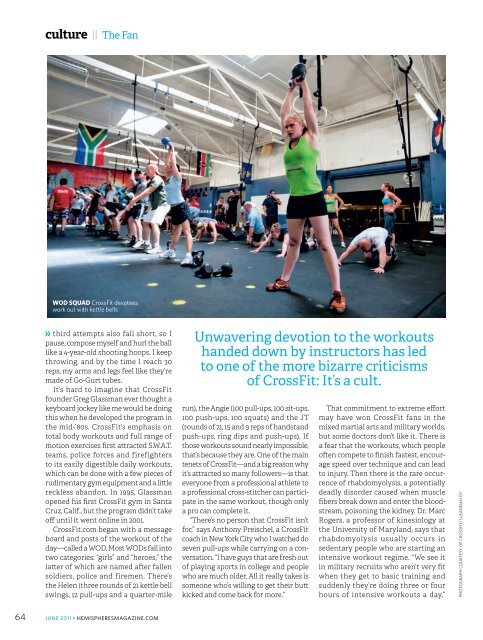june-2011
june-2011
june-2011
You also want an ePaper? Increase the reach of your titles
YUMPU automatically turns print PDFs into web optimized ePapers that Google loves.
culture || The Fan<br />
WOD SQUAD CrossFit devotees<br />
work out with kettle bells<br />
third attempts also fall short, so I<br />
pause, compose myself and hurl the ball<br />
like a 4-year-old shooting hoops. I keep<br />
throwing, and by the time I reach 30<br />
reps, my arms and legs feel like they’re<br />
made of Go-Gurt tubes.<br />
It’s hard to imagine that CrossFit<br />
founder Greg Glassman ever thought a<br />
keyboard jockey like me would be doing<br />
this when he developed the program in<br />
the mid-’80s. CrossFit’s emphasis on<br />
total body workouts and full range of<br />
motion exercises fi rst a racted S.W.A.T.<br />
teams, police forces and firefighters<br />
to its easily digestible daily workouts,<br />
which can be done with a few pieces of<br />
rudimentary gym equipment and a li le<br />
reckless abandon. In 1995, Glassman<br />
opened his fi rst CrossFit gym in Santa<br />
Cruz, Calif., but the program didn’t take<br />
off until it went online in 2001.<br />
CrossFit.com began with a message<br />
board and posts of the workout of the<br />
day—called a WOD. Most WODs fall into<br />
two categories: “girls” and “heroes,” the<br />
la er of which are named a er fallen<br />
soldiers, police and firemen. There’s<br />
the Helen (three rounds of 21 ke le bell<br />
swings, 12 pull-ups and a quarter-mile<br />
64 JUNE <strong>2011</strong> • HEMISPHERESMAGAZINE.COM<br />
Unwavering devotion to the workouts<br />
handed down by instructors has led<br />
to one of the more bizarre criticisms<br />
of CrossFit: It’s a cult.<br />
run), the Angie (100 pull-ups, 100 sit-ups,<br />
100 push-ups, 100 squats) and the JT<br />
(rounds of 21, 15 and 9 reps of handstand<br />
push-ups, ring dips and push-ups). If<br />
those workouts sound nearly impossible,<br />
that’s because they are. One of the main<br />
tenets of CrossFit—and a big reason why<br />
it’s a racted so many followers—is that<br />
everyone from a professional athlete to<br />
a professional cross-stitcher can participate<br />
in the same workout, though only<br />
a pro can complete it.<br />
“There’s no person that CrossFit isn’t<br />
for,” says Anthony Preischel, a CrossFit<br />
coach in New York City who I watched do<br />
seven pull-ups while carrying on a conversation.<br />
“I have guys that are fresh out<br />
of playing sports in college and people<br />
who are much older. All it really takes is<br />
someone who’s willing to get their bu<br />
kicked and come back for more.”<br />
That commitment to extreme eff ort<br />
may have won CrossFit fans in the<br />
mixed martial arts and military worlds,<br />
but some doctors don’t like it. There is<br />
a fear that the workouts, which people<br />
o en compete to fi nish fastest, encourage<br />
speed over technique and can lead<br />
to injury. Then there is the rare occurrence<br />
of rhabdomyolysis, a potentially<br />
deadly disorder caused when muscle<br />
fi bers break down and enter the bloodstream,<br />
poisoning the kidney. Dr. Marc<br />
Rogers, a professor of kinesiology at<br />
the University of Maryland, says that<br />
rhabdomyolysis usually occurs in<br />
sedentary people who are starting an<br />
intensive workout regime. “We see it<br />
in military recruits who aren’t very fi t<br />
when they get to basic training and<br />
suddenly they’re doing three or four<br />
hours of intensive workouts a day,”<br />
PHOTOGRAPH COURTESY OF CROSSFIT/SUSANNAH DY
















